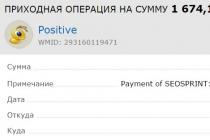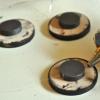Piezoelectric inkjet printing
Piezoelectric inkjet heads for printers were developed in the seventies. In most of these printers, the ink chamber is pressurized by a piezoelectric disc that changes shape (bent) when an electrical voltage is applied to it. Curving, the disk, which serves as one of the walls of the ink chamber, reduces its volume. Under the action of excess pressure, liquid ink is emitted from the nozzle in the form of a drop.
The pioneer of piezoelectric technology, Epson, was unable to successfully compete in sales volume with its competitors Canon and Hewlett-Packard due to the relatively high technological cost of piezoelectric printheads - they are more expensive and more complex than bubble printheads.
Bubble jet printing (bubble-jet)
Hewlett-Packard created the first inkjet printer using ThinkJet bubble technology in 1985. Canon and Hewlett-Packard now hold most of the technology's patents, and by exchanging licenses they have managed to capture almost the entire global market.
Some of the products they sell under their own trademarks, some - on the basis of licensing agreements under the trademarks of partners. They also make huge profits from trading "hearts" inkjet printers- printheads and other electromechanical "organs" associated with them.
The success of these printers was due to the fact that they provided print quality close to that of laser printers, at the price of a good dot matrix printer. The print quality of such devices depends on the size of the dot from the drop of ink, and it is very small. The design of the print head made it easy to achieve a resolution of 300 dpi. Halftones on the ThinkJet turned out no worse than on laser LaserJets.
As just mentioned, both Canon and Hewlett-Packard manufacture products using the same imaging process, which can be defined as thermal inkjet technology.
Hewlett-Packard calls it simply inkjet technology, while Canon calls it bubble-jet technology. In printing systems using bubble inkjet technology, text and graphics are reproduced when ink droplets from very thin nozzles hit the paper. It happens like this.
A heating element is built into the wall of the nozzle. When an electrical impulse is applied, its temperature rises sharply. Therefore, almost all ink in contact with the heating element evaporates instantly. The expansion of the vapor causes a shock wave. Under the action of excess pressure, a drop of ink is literally "shot" from the nozzle, as from a pistol barrel. After the “shot”, the ink vapor condenses, the bubble collapses and a zone of low pressure is formed in the nozzle, under the action of which a new portion of ink is sucked in.
An important feature of such a printing device is the simplicity of the design of the nozzles. Moreover, in addition to low manufacturing costs, such devices have a number of other advantages: - high reliability of each nozzle simplifies the design and, consequently, reduces the size of the printing unit, since it is not necessary to provide the possibility of replacing nozzles; - nozzles can be placed much closer to each other, and this increases the print resolution; - quiet operation of the print head.
Despite their dominance in the inkjet market and mutual license exchanges, Canon and Hewlett-Packard continue their brutal competition for the consumer. As a result, millions of users benefit, as the main tool in the fight is the continuous improvement of the print quality of the inkjet heads.
The difference between the print heads is that the heating element in Canon's head is located on the side of the nozzle, while Hewlett-Packard's is at the back. Therefore, in a Canon head, ink flows in a straight line, while a Hewlett-Packard head has a special ink reservoir inside.
From the user's point of view, the design differences are small at first glance, but in some cases they can be decisive when choosing between devices equipped with printheads from these two manufacturers. For example, CalComp's TechJet series of inkjet plotters are equipped with Canon heads. Those who worked with the first Hewlett-Packard inkjet plotters know that their main drawback, from the point of view of our user, is the pickiness to print paper. It is almost impossible to use ordinary whatman paper or other standard drawing materials, because either due to the unevenness of the paper, the writing head touches the sheet in some places and smears the ink that has not yet dried, or the ink is absorbed too well into the paper and blurs. Using only Hewlett-Packard branded paper for printing is too expensive.
The developers of CalComp took into account the fact that the width of the working field of an A0 format plotter is 4 times greater than that of a printer, therefore, with the same sheet curvature, the absolute value of its lagging behind the plotter roller can be significantly higher. Conclusion - it is necessary to increase the gap between the head and the sheet of paper. It was Canon's success in miniaturizing heads and increasing print resolution that allowed CalComp designers to move the head away from the sheet without compromising the quality of the resulting image on new plotters. Now the gap has increased to almost 6 mm, which allows you to use any Whatman paper, even one that is slightly damp at first and then dried up.
Canon's new inks have also made it easier to choose paper for the plotter - now the lines on the drawings do not blur, as the ink simply does not have time to spread - they dry out.
In this article, we will talk about such a popular type of printing as piezoelectric inkjet printing.
Inkjet Printing: What is it?
Piezoelectric inkjet printing is a type of printing in which an image is applied to the printed material using a print head. Such a head consists of hundreds of small nozzles, from which liquid dye is pushed out under the action of the membrane - paint.
T Printing technology piezoelectric inkjet allows you to get a very high quality image, from high resolution. The size of the dye droplets is tens of micrometers in diameter, which is less than the thickness of a human hair.
Piezoelectric inkjet printing process
 The printing process itself looks like this: the printed material is fed from a given speed, and the print head moves perpendicular to its movement. It moves from one edge of the material to the other, after which the material advances a certain step, and the print head makes a new pass.
The printing process itself looks like this: the printed material is fed from a given speed, and the print head moves perpendicular to its movement. It moves from one edge of the material to the other, after which the material advances a certain step, and the print head makes a new pass.
Thus, all material is sealed.
This printing method was developed from the mid-70s, but for the first time in serial production applied by Epson, and piezoelectric inkjet printing could be seen in its printers.
Principle of printing
The name of the seal comes from the piezoelectric elements that are used in this technology. The fact is that the dye is pushed out of microscopic nozzles under the influence of pressure, which is created by piezocrystals. These elements are capable of changing their dimensions under the influence of an electric current.
Thus, when the positive current changes to negative, the size of the crystal changes, and it, like a piston, pushes a microscopic particle of paint out of the nozzle, which falls on the material.
The volume of the ink drop depends on the size of the nozzle, the ejection chamber, and the force with which the crystal pushes the ink out.
Thus, by changing the electric field, it is possible to control the image to be obtained.
Piezoelectric printing advantages and disadvantages
Like any technology, piezoelectric printing piezoelectric inkjet color has disadvantages and advantages. Let's briefly consider them.
Advantages

Flaws
 1. Sometimes, in order to obtain a high-quality image, the print head must pass over the same page several times. This negatively affects the speed and cost of printing.
1. Sometimes, in order to obtain a high-quality image, the print head must pass over the same page several times. This negatively affects the speed and cost of printing.
2. Dried ink or air ingress can clog the nozzles, resulting in poor print quality. To restore the properties of the print head, you need to clean it.
Often the cause of dry printer nozzles is the use of low-quality counterfeit inks.
3. Printers that use this technology have increased requirements to the quality of the material. After all, the ink has a liquid consistency, and can blur on loose papers, which degrades the quality of the resulting print. It will be less clear, with blurry borders.
True, in recent years, Epson has developed the new kind ink (Epson DURAbrite), which does not require high paper quality requirements. In addition, such paints have increased resistance to water and sunlight.
4. Sometimes a defect is possible when ink drops do not fall exactly on the right place on the printed material and when detailed consideration it can be seen.
5. As a rule, the print head is installed directly on the printer, and is not variable. In addition, this part of the printer device is quite expensive compared to printer heads that use other printing technologies.
Sometimes, the cost of replacing a print head can almost equal the price of the printer itself.
But on paper inkjet printing, the picture quality will be very good.
As you can see, piezoelectric is widely used due to its reliability and print quality. And all this at a low cost.
We believe that our answer to the question “Piezoelectric inkjet printing is it” satisfied you and you received information about the principle of operation, advantages and disadvantages of this type of printing.
In conclusion, we note that in addition to the technology we have described, printers (piezoelectric printer) often use thermal inkjet, bubble or. But that's a topic for another article.
By the principle of operation, inkjet printers resemble matrix printers, only instead of needles hitting the ink ribbon, ink in inkjet printers is applied directly to the paper with drops of ink through very small holes called nozzles.
Currently, two printing technologies are most widely used in the inkjet printer market: thermal jet, in which the activation of the paint and its ejection occur under the influence of heat, and piezoelectric, in which the ejection of paint occurs under pressure created by the vibration of the membrane.
These are fundamentally different technologies with their pros and cons.
Piezoelectric printing uses the ability of piezoelectric crystals to deform when subjected to an electric current. This allows you to control the size of the drop, the thickness of the jet, and even the speed of ejection of the drop onto the paper. All this allows you to get high-resolution images. Also, the advantage of this technology is the naturalness of color reproduction, and this is one of the conditions for high-quality photo printing. Piezo printing technology invented and patented by the company Epson. Brother uses both technologies.
To date, piezo inkjet printing is the most reliable in relation to others. With proper care, the life of the head is comparable to the life of the printer itself. As a rule, the piezoelectric printhead is stationary, that is, not replaceable along with the cartridge. But along with this there are a number of problems, such as a very expensive repair and replacement of the head. In addition, piezo inkjet heads are prone to high ink requirements, the possibility of air infiltration when changing cartridges, or when ink runs out in the CISS. When printing infrequently, the head nozzles tend to clog or slant.But if you print often, you won't find a better piezo inkjet head.
In thermal inkjet technology, ink is applied to paper by heating, applying temperatures up to 600 C. At the same time, the quality of thermal inkjet printing is an order of magnitude worse than piezo inkjet printing. And all because of the explosive nature of the drop and the appearance of satellites, or satellite drops. Hence the distortion of high-quality images when printed. In addition, as a result of temperature, carbon deposits and scale are formed, clogging the nozzles and leading to a deterioration in color reproduction, the printer begins to streak. In addition, temperature fluctuations contribute to the destruction of the print head, which burns out when overheated. This is the main disadvantage of such PGs. But, as a rule, thermojet PGs are less expensive than piezojet PGs and are combined with a cartridge. As a result, they are replaced more often and at lower financial costs.
Attention! If thermal inkjet cartridges are mistakenly loaded with piezo ink, the consequences can be dire.
There are two main printing technologies on the market today for printing devices: piezoelectric and thermal inkjet.
Piezoelectric printing technology is developed on the ability of piezoelectric crystals to deform under the influence of electricity. Due to the use of this technology, it became possible to control printing, namely: to monitor the size of the drop, the speed of its exit from the nozzles, as well as the thickness of the jet, etc. One advantage of such a system is that the droplet size can be controlled. This ability allows you to get better images.
To date, experts have proven that the reliability of such systems is much higher than other inkjet printing systems.
When using this technology, the print quality is very high. Even universal and inexpensive models allow you to get images of the highest quality and high resolution. Also, the most important advantage of PU with a piezo system is high color rendering, which allows the image to look bright and saturated.
Epson technologies - time-tested quality
The printheads of EPSON inkjet printers are of high quality, and this is precisely what explains their high price. If you use a piezoelectric printing system, then you are guaranteed reliable operation of the printing device, and the print head does not dry out or clog due to the fact that it has minimal contact with air. The piezoelectric printing system was developed and implemented by EPSON, and only EPSON holds a patent for this system.
The thermal inkjet printing principle is used in Canon, HP, Brother printers. By heating the ink, they are transferred to the paper. By means of an electric current, liquid ink is proportionally heated, which is the reason for the name this method printing - thermal jet. An increase in temperature reproduces a heating element, which is located inside the thermal structure. With a strong increase in temperature, the main part of the paint evaporates, the pressure in the structure quickly rises, and a small drop of paint comes out of the heat chamber through a precision nozzle. This process is repeated repeatedly after one second.
The main disadvantage of the thermal inkjet method is that with such a printing technology, enough a large number of precipitation, which over time can disable it. Also, this scale clogs the nozzles over time, which leads to a loss in quality and print speed of the printer.
Also, devices that use thermal inkjet printing, due to constant temperature fluctuations, the print heads deteriorate, as it corny burns out under the influence of enormous temperature. This is the main disadvantage of such devices. The period of operation of the Epson PG MFP is absolutely identical to the service life of the device itself. This was made possible thanks to the high-quality materials from which the print head was developed. Customers who use thermal inkjet printing will often need to change the print head as the high temperature it will often burn out, which will significantly increase financial costs. The quality of the print head will also make a huge difference if users are using remanufactured cartridges.
Using an Epson inkjet printer in conjunction with refillable cartridges is very beneficial, as it improves the quality of the printer and reduces the cost of each printed image.
The print head of EPSON printers is of great importance not only for the stable operation of the printer. PG Quality allows you to increase print quality and print speed. Also, if the print head does not come into contact with air and dries up, the user will not have to change it, and therefore spend money in vain. Devices that use the thermal inkjet principle of operation can overheat greatly, and accordingly the print head can also overheat, which, if overheated, can simply burn out and go out of service.
As numerous checks and tests show, in order to print as economically as possible and at the same time be bright and effective, engineers recommend using EPSON printers with CISS. EPSON devices work much longer and more efficiently with the LF system than other similarly priced remote control units from other manufacturing companies.
Epson is a trusted manufacturer of quality products that make your job easier and more productive.
There are two main printing technologies in the inkjet printer market: piezoelectric and thermal inkjet.
The differences between these systems are in the way the ink drop is brought to the paper.
Piezoelectric technology was based on the ability of piezoelectric crystals to deform when subjected to an electric current. Thanks to the use of this technology, full control of printing is carried out: the size of the drop, the thickness of the jet, the speed of ejection of the drop onto the paper, etc. are determined. One of the many advantages of this system is the ability to control the droplet size, which allows you to get high-resolution prints.
The reliability of the piezoelectric system has been proven to be significantly higher compared to other inkjet systems.
The print quality of piezoelectric technology is extremely high: even the most versatile low-cost models produce near-photographic quality and high resolution prints. Also, the advantage of printing devices with a piezoelectric system is the naturalness of color reproduction, which becomes really important when printing photos.
The printheads of EPSON inkjet printers have high level quality, which explains their high cost. With a piezoelectric printing system, reliable operation of the printing device is ensured, and the print head rarely fails and is installed on the printer, and is not part of the replaceable cartridges.
The piezoelectric printing system was developed by EPSON, it is patented and its use is prohibited by other manufacturers. Therefore, the only printers that use this system printing is EPSON.
Thermal inkjet printing technology is used in Canon, HP, Brother printers. The supply of ink to paper is carried out by heating them. The heating temperature can be up to 600°C. The quality of thermal inkjet printing is an order of magnitude lower than that of piezoelectric printing, due to the inability to control the printing process due to the explosive nature of the drop. As a result of such printing, satellites (satellite drops) often appear, which interfere with obtaining high quality and clarity of prints, leading to distortion. This disadvantage cannot be avoided, as it is inherent in the technology itself.
Another disadvantage of the thermal inkjet method is the formation of scale in the print head of the printer, since the ink is nothing more than a collection of chemicals dissolved in water. The scale that forms over time clogs the nozzles and significantly spoils the print quality: the printer starts to streak, color reproduction deteriorates, etc.
Due to constant temperature fluctuations in devices using thermal inkjet printing technology, the print head is gradually destroyed (burns out under the action of high temperature when the fusers overheat). This is the main disadvantage of such devices.
The service life of the print head of EPSON printers is the same as that of the device itself, due to the high quality of the PG workmanship. Users of thermal inkjet devices will have to buy a new print head and replace it every time, which not only reduces the durability of the printer, but also significantly increases the cost of printing.
The quality of the print head also matters when using non-original Supplies, in particular CISS.
The use of Epson CISS allows the user to increase print volumes by 50%.
The print head of EPSON printers, as already mentioned more than once in this article, is of high quality, due to which an increase in print volumes does not negatively affect the operation of the printer, but rather allows the user to get maximum savings without compromising print quality.
Due to the characteristics of printers using thermal inkjet technology, an increase in print volumes can lead to the failure of the printer's PG.
Observations show that in order to obtain maximum savings with perfect print quality, it is more expedient to use EPSON printers with CISS. EPSON printers work with the continuous ink supply system more stable than printers from other manufacturers.














